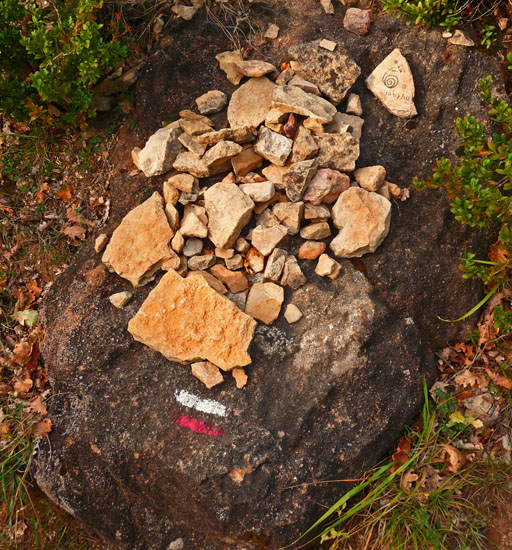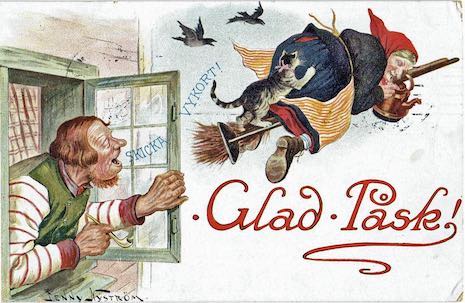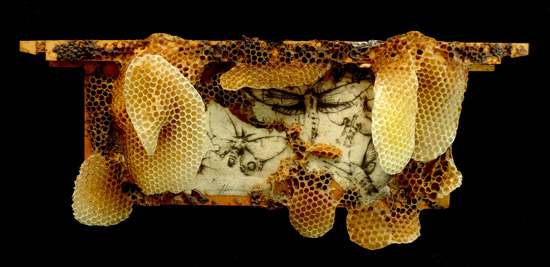Jim Ross – Finding Stillness in Movement
Jim Ross
Finding Stillness in Movement
After slowing to a trickle, the pilgrimage toward Santiago—along The Way of Saint James—began booming back fifty years ago as part of a global uptick in pilgrimage across faith traditions. Trails from all over Europe, four across France alone, merge to send travellers toward Santiago. For many, walking on The Way is an act of surrendering to The Way itself and letting It work Its wonders. In doing so, walkers (and smaller groups travelling by bike, wheelchair, or horseback) join the legions who, for over a millennium, walked to commune with nature and to experience revitalization and a restored perspective. Many communities, through which the pilgrims pass, came into existence a thousand years ago specifically to support pilgrims.

Jim Ross, Burdens Left Behind by Directional Sign, photograph, 2010. Many pilgrims symbolically leave their burdens behind as they trek. This pile is above one of the many red-and-white directional signs along The Way.
Most people find it difficult to carve out of their frantic, fractured lives the six to ten weeks needed to walk the entire route. Many instead plan to walk for, say, two weeks now, picking up the next time where they left off. Daily, pilgrims walk for hours, often over challenging terrain. Most pilgrims carry their immediate possessions on their backs. In arriving at new places daily, some hardly pause except in sleep. Most interrupt their walking whenever the spirit says it’s time to hear the enveloping stillness. In moving, they discover a stillness that the disquietude they experienced prior to the pilgrimage blocked. And that stillness opens the door to moving in directions they couldn’t previously fathom. As I talked with other pilgrims, it became clear that nearly all sought healing, realignment, and/or direction; some, forgiveness.
When I first arrived in France, I spent time with friends who questioned whether my embarking on the pilgrimage was wise on the grounds that I hadn’t trained adequately, didn’t speak French, and had no hotel reservations. I said I’d been training all my life, two people who had the will to communicate could do so despite language barriers, and pilgrims historically travelled without making reservations, trusting that The Way would provide. But after setting out, I wondered, were they right? When day was done, would I be able to find an inn? Would there be room for me? Would the trail be marked clearly enough that I’d be able to follow it? Would potable water be readily findable? Were warnings about vicious dogs over-stated? What about claims that each day walking on The Way would be more difficult than any day in our pre-pilgrimage lives? Would I hold up walking 15 miles per day when I’m accustomed to a third of that and have no backpacking experience?

Jim Ross, Pont d’Estaing, Estaing, France, photograph, 2010.
I’d be walking through the French midi-Pyrenees on a rolling path that periodically dips down to villages built along rivers. Those dips require steep descents on arrival and ascents at departure. My intent was to restore balance, not by ruminating, not by over-planning, but by letting the act of movement over a place with deep history work its wonders. I had to trust that every night I would find dinner, shower, and a place to rest my head.

Jim Ross, Grazing Sheep, photograph, 2010. Grazing animals provides reassurance, company, entertainment, and role models.
Getting Lost
Ordinarily when I travel, I let myself get lost deliberately because it leads to surprises. On The Way, I couldn’t get lost and stay on the prescribed path. Still, I got lost.
Perhaps in reading guidebooks I skipped over sections on signage. I knew that a white-over-red stripe painted on a tree, rock, fence, barrel, or rusted-out tractor meant, ‘Go this way.’ It took me too long to discern that a red-and-white X means “Not this way” and a hooked white-over-red symbol means turn right or left depending on a hook’s direction. For a while, I walked on instinct, almost oblivious to signage. As a result, I sometimes found myself miles off course. In my defence, sometimes the ‘Go this way’ symbols weren’t readily visible or suggested ambiguous courses of action. And, because it was October, I often went hours without seeing another soul.

Jim Ross, Pilgrim Directional Signs, photograph, 2010. The red-and-white bars, barely visible in the middle of the tree trunk, often suggested ambiguous courses of action.
There were advantages too of accidentally walking the road less travelled. I also learned there were ‘variants’, meaning segments of trail that weren’t considered the main path, but were recognized as alternate routes. Veering off course opened the doors of possibility. I saw my first porcupine in the wild. I chanced upon a village where every home was half in ruins, where a woman wearing a red sweater greeted me in French with, ‘Has God ever given us a more beautiful day?’ Another time, I came upon the 11th century chapel of St. Hiliarian. A cemetery adjoining the chapel had potable water. I came to realize that cemeteries are reliable sources of drinking water.

Jim Ross, St. Hilarian’s Chapel and Cemetery, photograph, 2010. The 11th century chapel of St. Hilarian taught me cemeteries usually have potable water.
Lodging
I resisted creating an itinerary of where I would stay each night because it violated the notion I was surrendering to The Way. Since it was October, I figured I’d have little competition in finding places to rest my head.
One of my first days, as the sun sounded its final trumpet, I began doubting I’d reach the convent where I hoped to stay. I came upon a doorless, dirt-floored,17th century shepherd’s shelter. It had a concrete bench with a rustic wood-slat top, which looked like a tolerable bed. I had a space blanket for warmth. Then I remembered another warning: ‘Vipers come out to play at night.’ I resumed walking. Then, after sunset, my right foot caught on a root and I began falling. I flipped 180 degrees, touched down hard, rolled from left to right, and nearly slammed my head on an ancient stone wall. When I finally reached the convent, a 500-year-old nun let me in and led me to dinner. The simple pilgrim’s dinner was over so I was brought to a more elaborate dinner of all the pilgrimage coordinators from the region, all thirty of them.

Jim Ross, Doorless Shepherd’s Shelter (inside), photograph, 2010. I decided this doorless shepherd’s shelter wasn’t where I would pass the night.
That became my signature: Approaching the next destination after dark, with no clear plan of where I might find dinner and lodging. Strangers plucked me out of the darkness. Still walking, stiffly, even feverishly, not thinking clearly. In one instance, I was walking unsafely after dark on a heavily-trafficked road. A Dutch woman pulled over in her Beetle and drove me to the village’s official pilgrim shelter. While I extricated myself, she ran inside, shouting, ‘I have a pilgrim,’ as if she just found one of Peter Pan’s lost boys. Another time, well after 10 p.m., I was rescued and brought to the priest’s house, where I was given a sheet of bubble wrap in which to cocoon myself on the visitor’s kitchen floor. This was the price I paid for taking in the path at my own pace and paying little attention to where I might spend the night. To make matters worse, many shelters close for the winter in October, reopening in April.

Jim Ross, Abandoned Shepherd’s Shelter, photograph, 2010. Shelters that once housed shepherds punctuated the landscape.
Dormitories
I hadn’t slept in a dormitory-style room since I was 17. I didn’t exactly mind sharing but I tend to be restless during night, emit a cacophony of sound effects, and am up and down to the bathroom. My sharing a dormitory wouldn’t work for anyone. I began inquiring about availability of single or double rooms. An incidental advantage of getting a private or double room was not having to compete with my roommates to recharge camera batteries, cell phones, and other devices. Most dorm rooms weren’t designed to allow multiple people to charge their devices simultaneously.

Jim Ross, My Monastery Cell, photograph, 2010. My cell at the monastery necessitated effective use of space.

Jim Ross, The View from my Monastery Cell, photograph, 2010.
Sustenance and Hydration
Every place I stayed fed me well. Nearly all served multi-course dinners with freely-flowing wine, either as part of the lodging cost, which was nominal, or for a small extra fee. Breakfasts consisted of breads, coffee, and fruit and sometimes fruit juice, cheeses, and/or meats. Discovery: soft cheese is a dead-ringer for yogurt. Some places served coffee in bowls, following local custom. While walking, I nibbled on dried blueberries and hard cheese.

Jim Ross, My Monastery Breakfast, photograph, 2010. A typical breakfast consisted of breads, juice, coffee, and fruit (here cherries).
When I came upon pear or apple trees heavy with fruit, I usually picked up freshly-fallen fruit from the ground. If a tree grew wildly in a forest, I took my pick. I found plenty of fig trees, but most figs had dried up and/or turned mouldy.
Many people left out drinks (water or tea) or fruit (apples, pears, plums). Some villages served drinks and snacks under a roof. Some even incorporated bathrooms, community bread ovens, and/or resting areas.
When I saw that one family left out baskets of large, shapely pears, I assumed they were meant for pilgrims. They must have laughed at the sight of me trying to bite through their thick, furry skin and chew their sour, hard flesh until swallowable. Anyone in France, whom I told about this experience, laughed uncontrollably while repeating, ‘You fool! That was quince. You have to cook it.’ Widely used in jams, quince or marmelo is the root of the word ‘marmalade.’ If I can teach anyone anything in the time I have left on earth, it’s that you can’t eat quince raw.

Jim Ross, A Basket of Quinces, photograph, 2010. Quince resembles hefty pears but are nearly impossible to eat raw.
Staying hydrated presented greater challenges. To travel light, I carried relatively little water. I ran out daily except for sips kept in reserve. I stayed vigilant for “eau potable” signs. In the absence of a sign, I refused to assume water was safe unless the setting clearly implied it (e.g., public water fountains). Being dehydrated toward day’s end increased anxiety about reaching the next destination and probably made me a tad delirious. I kept my eyes peeled for cemeteries. In my next incarnation, I plan to invent concentrated water.
The Most Difficult Day
One guidebook I read before leaving home claimed that every day on the pilgrimage would be more difficult than every day in one’s prior life. Once I began walking, I quickly rejected that claim. There were hard days when I had to concentrate intensely on every moment, hoping as I hopped from rock to rock that my instincts in using my walking sticks would fire timely to restore balance. But, there were also days when it felt like I was walking in paradise.
I met two women from Provence who, at their final stop, shipped home all their clothes so they could fill their backpacks with precious cargo: chestnuts. While I love chestnuts, I didn’t love them on the pilgrimage because they often blanketed the trails, with this year’s joining remnants from prior years, making footing unpredictable.

Jim Ross, My Name in Chestnuts; photograph, 2010. After hearing me complain, another pilgrim wrote my name in chestnuts to welcome me.
Attack Cows?
The small herds of deer that roam my suburban neighbourhood at home sometimes accidentally bowl people over. More often, they surge suicidally into traffic and cause fender benders. Once, I was bitten by a neighbour’s dog. Should I fear dogs along The Way? I was more worried about feral cats. Friends warned my real nemesis could be cows, and if they charge at you and mean business, barbed wire won’t hold them back.

Jim Ross, Attack Cow, photograph, 2010. Barbed wire won’t hold them back!
Most of the cows I met wore impressive horns that cause naïve cow-gazers to believe they’re bulls. Idyllic-looking creatures, they often play melodic bells and in May are crowned with wildflower garlands. Evidently, they’re not always mild-tempered. I learned that when I snapped a photo of a mottled cow that wasn’t going to let a little barbed wire keep us apart.

Jim Ross, Zita, Pilgrim’s Companion, photograph, 2010.
Fortunately, hours earlier, I was picked up by a kind-looking German shepherd named Zita, who led me to the chapel of St. Roch, the patron saint of dogs and dog lovers, and led me inside. Over the next eleven hours, she shielded me from oncoming traffic, counter-charged that fussy cow and chased her away, and used her night vision to guide us through a forest after nightfall. I also rescued her from cars speeding on a busy road. I hated parting with my Zita, but that was a condition of the priest’s taking me in for the night.

Jim Ross, Aubrac Cows, photograph, 2010. Aubrac cows have long horns that result in being mistaken for bulls.
Experiencing the Sacred
Notions of what pilgrims considered ‘sacred’ varied widely. Some embraced traditional Christian beliefs. For many, communing with nature or experiencing villages we passed through was ‘sacred’. I think nearly all considered the ground we walked on ‘sacred’ because millions came and walked before us in search of healing and balance.
I learned a little about the profane side of sacredness. A thousand years ago, villages sought to get on pilgrimage routes because it meant big business for the Church. In addition, visiting pilgrims would need shelter, food, and hospitals and could be persuaded to buy indulgences and fake relics. To earn a spot on a pilgrimage route, a village had to have holy bones (i.e., the relics of saints).
How did villages lacking holy bones procure them? Absent other options, they stole them. For example, a 9th century monk from Conques went under cover for a decade at a monastery in Agen to get close enough to the relics of 4th century Saint-Foy to steal them. Spiriting away Saint-Foy’s relics made Conques a competitive pilgrimage site. As the pilgrimage routes to Santiago formed, Conques already had status and investors. The profane history of pilgrimage positioning suggests we re-think, ‘What makes something sacred?’

Jim Ross, Gate at Abbey of Saint-Foy, photograph, 2010. A gate at the Abbey of Saint-Foy incorporates an extreme form of barbed wire.
Human Contact and Getting Home
I went on the pilgrimage to get lost in a dark forest and breathe solitude into my lungs. After ritually exchanging ‘Bonjour’ with others I often remind myself, ‘I’m merely a pilgrim, by definition I’m only passing through.’ The break from solitude came at dinnertime, when most dinner conversations took place in French. Still, I came to feel part of a fabric. And every morning, I left solo as did nearly every other pilgrim.
By the end, on the eve of a National Strike, I began reaching out to villagers. One village had been in the throes of a pre-emptive National Strike for five days. I found myself reverting to my professional behaviour by interviewing activist students, noncommittal students, teachers, residents, and striking railroad workers. On my first attempt to catch a bus (to begin my journey home), a high school student sat beside me and offered to split her ham baguette in exchange for conversation. After this distraction caused me to miss my bus, I went back into town and spent three more hours with the students and railroad workers, who shared cheese, bread, and wine with me. In turn, I helped tend to their little children. The high school students offered me a coke. An older protest junkie offered cannabis. (I declined).
At the airport, I heard the National Strike might delay my flight home. I began rooting for the National Strike to keep me there. I decided I would go back to find Zita. Then my flight managed to get out after all. Nine months later, I went back and found Zita. AQ
























 When something catches her eye, she studies its movement and gravitates almost imperceptibly in its direction. As a call to alarm, allegro con brio, the heron straightens her neck, flaps her wings, and hovers above the canal, like a ballerina on pointe, arms held aloft.
When something catches her eye, she studies its movement and gravitates almost imperceptibly in its direction. As a call to alarm, allegro con brio, the heron straightens her neck, flaps her wings, and hovers above the canal, like a ballerina on pointe, arms held aloft.
 Not expecting this, she tips over clumsily, falling on her beak. She flaps her wings furiously to stand upright and doesn’t lose hold of the snake. Still not grasping what just transpired, the heron repeats the same maneuver: lifts her beak, inadvertently lifts her right thigh, falls over onto her beak, flaps her wings furiously, and uprights herself. Throughout, the heron holds on. The snake too hangs on.
Not expecting this, she tips over clumsily, falling on her beak. She flaps her wings furiously to stand upright and doesn’t lose hold of the snake. Still not grasping what just transpired, the heron repeats the same maneuver: lifts her beak, inadvertently lifts her right thigh, falls over onto her beak, flaps her wings furiously, and uprights herself. Throughout, the heron holds on. The snake too hangs on.